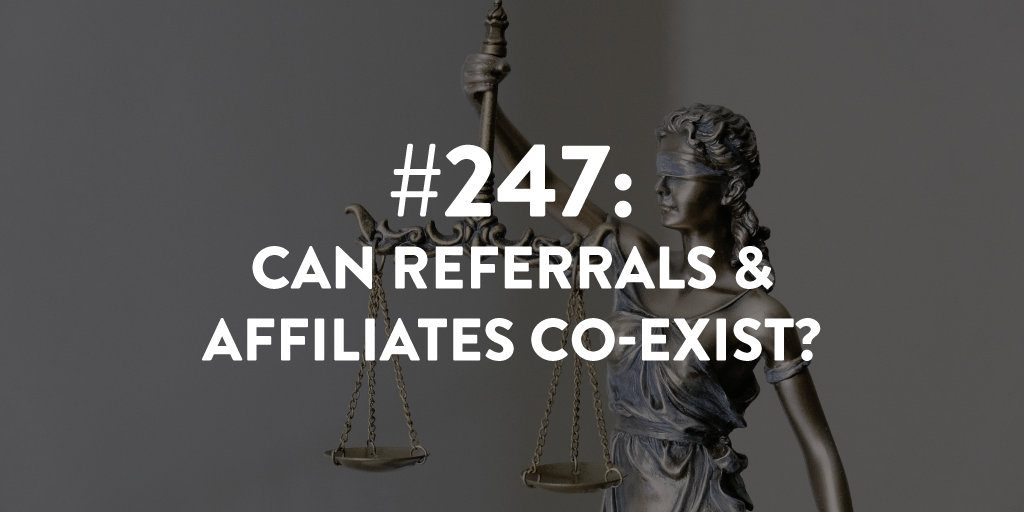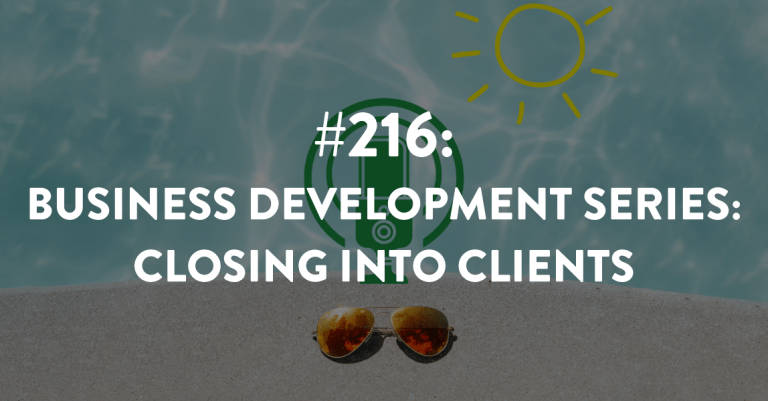Ep #247: Can Referrals & Affiliates Co-Exist?
Do you ever find yourself confused about the different terms used in business, such as referrals, affiliates, and joint venture partnerships? While these terms may seem interchangeable, each one requires a different approach to incentivize individuals or businesses to bring in clients, and it’s important to understand the distinctions between them and how they can co-exist in your business. So, in this episode, we’ll explore the nuances of each term and how to leverage them to bring in clients and grow your business.
Listen in as I dive into the differences between referrals, affiliates, and joint venture partnerships, as well as how to use them effectively. By understanding the unique characteristics of each type of partnership, you can develop targeted strategies to maximize their potential and take your business to the next level.
Links Mentioned During the Episode:
Is it time to get serious about joining Building a Referable Business™ (BRB)? First step is to submit your application BRB to see if you’re a fit.
Next Episode:
Next episode is #248, and we’re going to chat about the guiding principles of referrals.
Download The Full Episode Transcript
Read the Transcript Below:
Stacey Brown Randall: Some people say that referrals and affiliates are the same thing, but they’re not, they are different. So, the question is, can they coexist in your business?
Hey there, and welcome to episode 247 of the Roadmap to Referrals Podcast, a show about helping you build a referral business, I’m your host, Stacey Brown Randall.
So, from time to time, I get questions about referrals and affiliates and joint venture partnerships or sometimes called strategic partnerships.
And they’re usually questions because there’s confusion around what they are. Are they the same? Are they different? And then of course, can they co-exist in my business? Should they coexist in my business? Lots of things come up and we start talking about referrals versus affiliates, versus joint venture or strategic partnerships.
So, we’re going to dive in and discuss them. First, let’s talk about the confusion around the terms, because I think that’s an important piece that people just don’t pay attention to. We all know and we teach our kids words matter, what you say matters.
Think about what you say to yourself, the little voice inside your head, whether that is playing a positive tape on repeat or a negative one, those words matter. The words we speak to others matter. Same thing with actually how we talk about the things in our business.
Now, I know some people will be like, it’s a stretch to go from the things I say to myself, and the words that I say to myself or the words I say to someone else versus the words I’m using to define things within my business.
But words matter because within the words are the meanings, and within the meanings become our beliefs around them, which means the actions that we take, and in business, that means the processes that we set up and how well and how clearly defined those are and how well they work for us.
So, I believe that people who group referrals and affiliates and joint ventures or strategic partnerships altogether are oversimplifying what are actually three very distinct types of ways that business or new clients can come into your business.
So, I believe that referrals and affiliates and joint venture, or sometimes called strategic partnerships are actually three different categories. And when you take those three categories and you lump them all together, you look at them as the same, you treat them as the same — that means that your processes and your procedures for them are the same as well.
But they are very, very different and how you go about generating clients from affiliates and clients from referral sources and clients from those strategic or joint venture partnerships, well, it looks different. The actual tactics and processes that you use within those different avenues, they’re actually very, very different.
Right down to the difference of what is the triggering science behind why somebody is a referral source versus why somebody is an affiliate, versus why somebody is a joint venture or strategic partner. The triggering mechanisms of why they want to be that for your business is different.
And it’s because of the root of how we are responding when we’re in one of those categories for your business, right down to the science. That’s how I think about it in terms of why it’s so important that we recognize that these are different ways or different avenues for bringing in business.
So, when we have confusion around the terms, and usually because folks are just grouping them all together, they just group all of them together and like, “This is like my referral affiliate category.” When we group them all together, we treat them all the same, but they need different things to trigger them to do what you’re hoping they will do, which is referrals from referral sources, affiliates sending you clients because there’s the triggering of the commission. And then of course, with those strategic or joint venture partnerships, they need you as much as you need them.
And so, I think it’s important, right now … some people may say, “Oh wow, Stacy, this is super nuanced and I don’t have time for that, it just is what it is in my business.” And guess what? We all are the big girls and the big boys of our businesses, so we get to make the choices of how we run it ourselves.
But I want you to understand that when you treat these differently in your business, that’s in large part how their co-existence actually works. Because when I’m an affiliate for your business … I’m not an affiliate for anyone’s business, but if I were — why I’m an affiliate is triggered differently than why I decide to refer someone to you.
And so, let’s define these categories and then dive into the coexisting in your business and ultimately what that looks like. So, let’s talk about referrals (might talk about referrals a lot). So, the idea of referrals coming into your business, they come from a referral source, which is a human that has decided to put their reputation on the line and refer a client to you.
Now, the way we look at referrals in my world is that those referrals come because you have a relationship with the referral source, the prospect has a problem that the referral source knows that you can solve, that’s why the referral source is going to refer that prospect to you.
There’s no compensation changing hands, and the client or the prospect, and hopefully becoming a paying client, they know they’re being referred because the referral source that they trust, trust you to solve the problem.
There’s nothing hidden about it, there’s no under the table pieces to it. Like under the table kickbacks and commissions and things like that happening.
It is truly, “Hey, you have a problem, I know the exact person who can solve it and I know they can solve it because if I had that problem, this is who I would go to, or this is who I have a relationship with, or this is who I’ve watched do this for a lot of other people. Or this is who I trust, this is who I believe that can help you as well, you should have a conversation with them.”
So, referrals and their referral sources that send those referrals to you, they have — if you think about their mindset and the reason behind why they do what they do, it’s all about helping that prospect, who’s going to become the referral.
The prospect who has a problem to try to help them find the right option to solve their problem. And there’s no by the way, just FYI, I’m getting a kickback on this. That’s just part of it in our world of how we define referrals, that doesn’t exist.
Different though referrals are from affiliates. So, affiliates are typically when somebody is promoting someone else’s business and they are getting paid to do that. And typically, if it’s done correctly, and in my personal opinion, legally, it’s disclosed upfront as well.
So, a couple of ways you see this show up in business is sometimes you’ll get an email, and somebody will be promoting somebody else’s online training or program or app, or some type of software, they’ll be promoting it on behalf of that person. And somewhere in that email, it should say, “Hey, by the way, if you click on this link and make a purchase, I’m getting a commission.” It should say that.
And typically, you see things, they’ll say, “Hey, if you click on any of these links, we’ll get a commission, but we wouldn’t recommend anything we don’t believe in,” that’s the typical standard language I feel like I see.
And so, you can get that, it can come in an email blast. You can be reading an article or a blog online, and there may just be a disclaimer at the top of the article that says, “Hey, some of these links are affiliate links, and if you click on them, we are going to earn a commission.”
And that is a legitimate way that people bring in cash, bring in revenue for their business is by doing affiliate, it’s sometimes referred to as affiliate marketing. And it’s like, who all do you have affiliate relationships with that when people trust you to click on that link and buy, you are going to make money from it?
But it’s very different from a referral. I know they sound similar, but they’re not, they could not be further from being similar except for the fact that they’re both bringing in clients. The mechanism of an affiliate, typically promoting somebody else’s business in that avenue — the triggering mechanism, is the compensation.
So, the triggering mechanism for referrals is helping somebody I know that has a problem and I’m going to connect them with the right solution provider. The triggering mechanism in the affiliate world is usually because I’m going to get paid, and that’s why I’m going to take the time to get an affiliate link, put it out there and promote it. And so, they’re just different, and different is not always bad.
But I believe referrals and affiliates are also then different from joint venture (JV) or strategic partnerships. Now, some people would make the argument that a joint venture partnership is the same thing as an affiliate. And you can define these how you want, what’s most important is that you pick a definition, and you stick to it, and that’s how you define what you define.
But I look at referrals as separate from affiliates, and then affiliates as separate from let’s call them strategic partnerships. My opinion of a strategic partnership is that there is somebody that needs to be sending business to you so that they can also do the business with their clients as well. There’s a strategic relationship there, there’s a strategic partnership there, and they need you in the same way that you need them.
Now, some people will look at strategic partnerships and they’re like, those to me are just my referral sources. And this is really why it gets a little gray. And it really depends on the business, on the industry that you’re in. If you look at your strategic partnerships as also referrals. I always say if there’s money changing hands, it’s not a referral. If there’s not money changing hands, it can certainly be considered a referral.
But a lot of strategic partnerships happen because two companies join up together and they’re like, “Hey, you need this and we need this, and we need both of our clients to have this, for this to work. So, we are going to have a strategic partnership,” and maybe there’s a discount offered.
So, “Hey, if you’re a client of ours and then you use this, what you’re going to need, then we’re going to offer you a discount.” So, sometimes it’s not payment, it’s the discount, is actually passed along to the client.
But it’s a strategic partnership where it’s just a different type of conversation that you would have with a strategic partner about like lead flow and about conversion rates, and closing ratio and what all those things look like when there is this alignment in terms of the business and having that strategic partnership. There’s not always a signed documentation of it, of course.
But there’s this understanding that, “Hey, you need this, and I need this, and we’re going to have the strategic partnership, and you’re not going to send those people to anybody else, and I’m not either.” And so, sometimes there are actual business agreements that are signed and then put in place together and sometimes not.
Like in some cases a strategic partnership could look like … and sometimes there is dollars exchanging hands as well. So, not only can there be like, “Hey, we have an agreement, there’s also dollars changing hands,” and that’s different, that’s our strategic partnership.
I’ve seen it before in terms of a CPA firm will bring in a financial planning group, and anytime the CPA firm has anybody that needs financial planning, they’ll send it to just those in-house, but out of house financial planners, and there’s typically always money changing hands on some way, shape or form.
Now, I don’t know if that’s still actually allowed, it’s been a very long time since I’ve been in the financial world that nuanced in the financial world to know. But that would be what we would refer to as a strategic partnership.
Now, as you’re listening to me talk about the difference between referrals with their referral sources and affiliates and those affiliate relationships, and then of course strategic partnerships, you might be like, “Wow, there’s differences, but it is nuanced.”
But it’s in the nuance, is where understanding the difference matters. Because if you’re in a strategic relationship, if you’re in a strategic partnership with another company, or somebody else, the idea there is that’s a committed strategic relationship, and you are probably having different types of conversations with them than you would probably be having with your referral sources because it’s different in terms of the type of relationship and the expectations from that relationship.
And I think it’s important that people understand the definitions and the difference between those definitions. So, the big question is, can they coexist in my business? Can I have referral sources that I’m not compensating, that I am taking care of with a referral touch point plan to generate more referrals from them in a given year?
So, can I have referral sources be separate from any affiliates that I’m actually paying to send people my way versus any strategic partnership that I also may be paying, or we have some kind of leave flow in and out from each other that may be happening in my business. So, can they coexist in your business?
The short answer is yes, of course. But I believe what makes that easy for you is understanding who’s in what bucket, who are your referral sources? Who are your affiliate relationships? Who are your strategic partnerships? And so, when you understand who’s in what bucket, that makes the coexisting a little bit easier. So, let’s talk about how referrals, affiliates, strategic partnerships can coexist.
Hey there, pardon the interruption. If you’ve been waiting for a sign, here it is. In all seriousness, if you’ve considered joining my coaching program, Building a Referable Business (BRB), it’s really important you get clear on what’s possible for you, what’s also included, and of course, how it all works.
You can get those answers without joining, you just need to submit an application. If you are approved to join BRB, you’ll receive all the details, plus a video that’ll explain how we double, triple, or quadruple our members’ referrals in one year.
Then once you have all that information, you can decide if joining BRB is right for you, but only you can decide, but you’ve got to have all the information to make a smart decision. Go to staceybrownrandall.com/referable to learn about everything you receive inside BRB.
Like access to our weekly office hour sessions with me, access to all the 18 referral strategies that I teach, and other ones that we’re cooking up this year. Plus, of course, a customized roadmap to follow every 90 days. Again, the link is staceybrownrandall.com/referable.
So, let’s talk about how referrals, affiliates, and strategic partnerships coexist in your business. I believe the easiest way to do this, and let me just tell you that the advice I’m going to give here, take and modify as you need to.
But if you’re a longtime listener of the podcast, you know that I’m a linear thinker and I think step by step by step, I think buckets. I think this grouping and then this grouping, and then this happens. I think this happens, then this happens, I’m very much a linear thinker. That doesn’t mean I can’t see the big picture, that doesn’t mean I can’t connect the dots really fast and all those good things.
But the truth is, when I am trying to understand something and apply it to my own business, or when I am trying to take something that I know and then teach it to others, I like to think about things from a linear perspective, step by step, bucket by bucket, and then what do we do when we’re in that bucket, or why are we doing this step before the next step.
So, my advice to you on how your referrals, affiliates, and strategic partnerships can coexist, are coming from that thought process. So, I believe the most important thing you can do is bucket this out, and if you have a bucket of who your referral sources are, and what you then do, the processes, the strategies, the tactics to generate more referrals — that’s a process contained in and of itself.
And if you’re in the referral source bucket generating referrals, you’re in that bucket. You’re labeled, you’re in that category, you have that label, which would be separate then if you had an affiliate bucket. If you have affiliates, then that bucket is just separate.
And when you think about affiliates in your business, let’s just look at this from the perspective of let’s say you have different levels of products or services that you offer. And so, maybe when somebody is referring someone to you, and it’s one of your higher level, or more top services, those are referral sources.
There’s no kickback being given, there’s no asking for those happening, you are taking care of your referral sources to generate more client referrals from them. But with affiliates, maybe you have some low dollar, if you have a piece of software or if you have something that you kind of sell that’s more low dollar — people could be an affiliate of that, but also not be a referral source.
And that just depends if they’re actually sending clients to you at different levels, like services versus products. Now, in some cases, you may not have affiliates at all in your business. I don’t. I used to. And how I used to do affiliates, is that they were always just separate from my referral sources. The relationship that I built with my referral sources looked different than how I maintained the relationship with my affiliates.
Because remember, the trigger for a referral source to send a referral to you is entirely different than the trigger for an affiliate to decide to promote your business, because the trigger for an affiliate is usually at the top of the list, the reason they’re doing it is the dollars. It’s the what payment can I be making? How much money can I make? What is this ultimately going to look like?
And so, from that perspective, as you look at these different buckets in your business, I believe that if you want them to coexist, you just have to put a label on them, put a category on them, understand who goes in the referral source bucket, who goes into the affiliate bucket? And if you have a strategic partnership, who goes into that bucket as well?
And understanding who goes into it, what type of clients do they bring to you? How do you manage and maintain those relationships, and how do you manage the processes around them, makes everything easier and makes it able to coexist?
I think when you try to muddy the water and you’re like I got referral sources and are they affiliates or are they not? Are we paying them or are we not? It muddies the water in terms of jumbling these all together.
So, to keep them coexisting (and you not going crazy of like what’s happening) is knowing who is an affiliate, who is a referral source, who are you in a strategic partnership with, or only have one, that’s okay too, like how you decide to run your business is fine.
Typically, the affiliates that I see though, I don’t see a lot of attorneys or financial advisors or interior designers having a whole bunch of affiliate relationships. Where I do see affiliate relationships is in E-commerce or SaaS-based businesses, where those are in the online course creator space. I see a lot more affiliates and strategic partnerships happening there.
But in professional services or in creative and professional services, talking about our attorneys, our CPAs, talking about our business coaches and consultants, real estate agents, interior designers, looking at that group of folks, typically, I see that you’re going to do more in the one bucket, it’s going to be referrals.
But if you are in the online space or the course creator space, or the E-commerce space or the SaaS, (software as a service) business you’re probably more likely to actually have affiliates. And that’s normal course of business for how that industry runs.
My big thing is that everything should be disclosed. If you have affiliates in your business and you are making payments when they send clients to you on their end and your end, that should just be disclosed. You don’t need to do any disclosing with referral sources because there’s no payment exchanging hands, everything’s different when you’re receiving referrals.
And then with strategic partnerships, I think it just depends, if there’s no payment changing hands, maybe you don’t need to disclose that relationship from that perspective of if there’s not a truly structured relationship there.
But every business is different, every industry is different, and how you’re going to decide what this looks like in your business is something that you need to do. But because I get the questions from time to time, “Can I have affiliates and referral sources?”
Or I’ll get the question of, “Hey, these are like strategic partners and to me, they just feel different from my referrals, can they coexist?” Well, I thought, what better way to do this than just dedicate an episode to it.
So, again, short answer is yes, your referrals, your affiliates and your strategic partnerships can coexist, but not as one big jumbled together category, and you treat them all the same and do all the same things for them.
You need to have them in their own separate categories, their own separate buckets, and definitely treating them differently, because again, remember the motivation to refer, versus promote your business as an affiliate versus be a strategic partnership, those motivations are very different.
And when the motivation is different, that means your tactics and your strategies and even your language changes and how you communicate changes, and then of course, the relationship you have with them changes based on, well, are they referring to you or are they an affiliate of yours? Or are they in a strategic partnership? And that’s the piece I want you to remember more than anything else.
Of course, as always, what we talk about can be found in our show notes page, including the transcripts to every single episode. And for this episode, you can find that at staceybrownrandall.com/247 and Stacey has an E.
Coming up next week is episode 248, and we are going to chat about the guiding principles of referrals because sometimes they just bear repeating.
But until then, you know what to do my friend, I want you to take control of your referrals and build a referral business. Bye for now.







